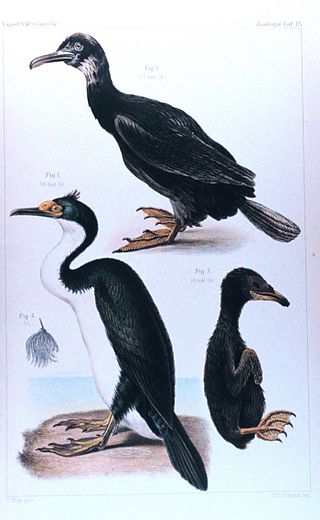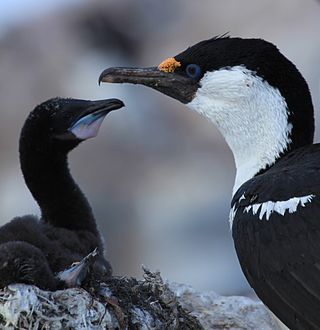
Phalacrocoracidae is a family of approximately 40 species of aquatic birds commonly known as cormorants and shags. Several different classifications of the family have been proposed, but in 2021 the International Ornithologists' Union (IOU) adopted a consensus taxonomy of seven genera. The great cormorant and the common shag are the only two species of the family commonly encountered in Britain and Ireland and "cormorant" and "shag" appellations have been later assigned to different species in the family somewhat haphazardly.

The European shag or common shag is a species of cormorant. It is the only member of the monotypic genus Gulosus. It breeds around the rocky coasts of western and southern Europe, southwest Asia and north Africa, mainly wintering in its breeding range except for the northernmost birds. In Britain this seabird is usually referred to as simply the shag. The scientific genus name derives from the Latin for glutton. The species name aristotelis commemorates the Greek philosopher Aristotle.

The Australian pied cormorant, also known as the pied cormorant, pied shag, or great pied cormorant, is a medium-sized member of the cormorant family. It is found around the coasts of Australasia. In New Zealand, it is usually known either as the pied shag or by its Māori name of kāruhiruhi. Older sources may refer to it as the "yellow-faced cormorant".

The spotted shag or pārekareka is a species of cormorant endemic to New Zealand. Though originally classified as Phalacrocorax punctatus, it is sufficiently different in appearance from typical members of that genus that for a time it was placed in a separate genus, Stictocarbo, along with a similar species, the Pitt shag. Subsequent genetic studies show that the spotted shag's lineage is nested within the typical shags.

The Otago shag, together with the Foveaux shag formerly known as the Stewart Island shag and in its dark phase as the bronze shag, is a species of shag now found only in coastal Otago, New Zealand.

The guanay cormorant or guanay shag is a member of the cormorant family found on the Pacific coast of Peru and northern Chile. After breeding it spreads south to southern parts of Chile and north to Ecuador, and has also been recorded as far north as Panama and Colombia – probably a result of mass dispersal due to food shortage in El Niño years. Its major habitats include shallow seawater and rocky shores.

The Cape cormorant or Cape shag is a bird endemic to the southwestern coasts of Africa.

The Socotra cormorant is a threatened species of cormorant that is endemic to the Persian Gulf and the south-east coast of the Arabian Peninsula. It is also sometimes known as the Socotran cormorant or, more rarely, as the Socotra shag. Individuals occasionally migrate as far west as the Red Sea coast. Despite its name, it was only confirmed in 2005 that it breeds on the Socotra islands in the Indian Ocean.

The rock shag, also known as the Magellanic cormorant, is a marine cormorant found around the southernmost coasts of South America. Its breeding range is from around Valdivia, Chile, south to Cape Horn and Tierra del Fuego, and north to Punta Tombo in Argentina. In winter it is seen further north, with individuals reaching as far as Santiago, Chile on the west coast and Uruguay on the east. The birds also breed around the coasts of the Falkland Islands.

The New Zealand king shag, also known as the rough-faced shag, king shag or kawau tūī, is a rare bird endemic to New Zealand. Some taxonomic authorities, including the International Ornithologists' Union, place this species in the genus Leucocarbo. Others place it in the genus Phalacrocorax.

The black-faced cormorant, also known as the black-faced shag, is a medium-sized member of the cormorant family. Upperparts, including facial skin and bill, are black, with white underparts. It is endemic to coastal regions of southern Australia.

The Auckland shag or Auckland Islands shag is a species of cormorant from New Zealand. The species is endemic to the Auckland Islands archipelago. It is a sedentary bird that primarily eats various crustaceans and fish. In recent years, roughly 1,000 pairs have been recorded. The Auckland shag is a colonial nester, building sizeable nests of, among other items, grass, twigs and seaweed. The Auckland shag lays three pale blue-green eggs in November–February. The incubation period is 26–32 days.

The imperial shag or imperial cormorant is a black and white cormorant native to southern South America, primarily in rocky coastal regions, but locally also at large inland lakes. Some taxonomic authorities, including the International Ornithologists' Union, place it in the genus Leucocarbo, others in the genus Phalacrocorax. It is also known as the blue-eyed shag, blue-eyed cormorant and by many other names, and is one of a larger group of cormorants called blue-eyed shags. The taxonomy is very complex, and several former subspecies are often considered separate species.

The red-legged cormorant, also known as the red-legged shag, red-footed cormorant, red-footed shag, Gaimard's cormorant and grey cormorant, is a species of cormorant resident to the coastline of South America. It is the only member of the genus Poikilocarbo. It is non-colonial unlike most seabirds. The red-legged cormorant has not been observed wing-spreading, which is unusual among cormorant species.

The Chatham shag, also known as the Chatham Island shag, is a species of bird in the cormorant and shag family, Phalacrocoracidae. It is endemic to the Chatham Islands of New Zealand. For a long time the species was placed in the genus Phalacrocorax; today it is mostly placed with the other blue-eyed shags of New Zealand and Antarctica in the genus Leucocarbo. Its closest relative is the Otago shag of South Island.

The Kerguelen shag is a species of cormorant endemic to the Kerguelen Islands in the southern Indian Ocean, one of the most isolated places on Earth. Many authorities consider it a subspecies of the imperial shag.

The Macquarie shag, Macquarie Island shag or Macquarie Island cormorant, is a marine cormorant native to Macquarie Island in the Southern Ocean, about halfway between Australia and Antarctica.

The Crozet shag, also known as the South Georgia cormorant, is a marine cormorant native to the Crozet, Prince Edward and Marion islands in the South Atlantic Ocean.

The Antarctic shag, sometimes referred to as the imperial cormorant, king cormorant, imperial shag, blue-eyed shag or Antarctic cormorant, is the only species of the cormorant family found in the Antarctic. It is sometimes considered conspecific with the Imperial shag.

The Foveaux shag, together with the Otago shag formerly known as the Stewart Island shag and in its dark phase as the bronze shag, is a species of shag endemic to Stewart Island/Rakiura and Foveaux Strait, from which it takes its name.





















